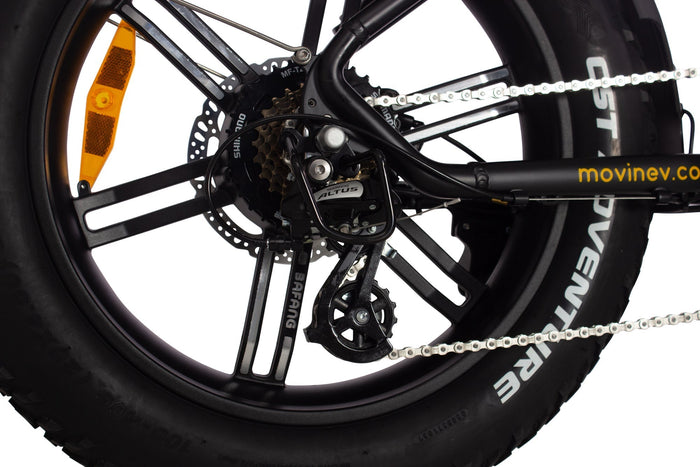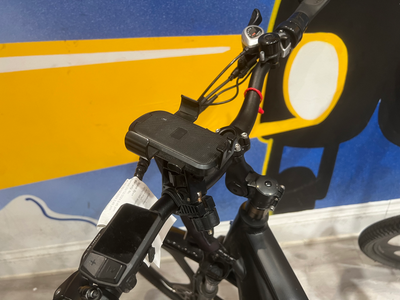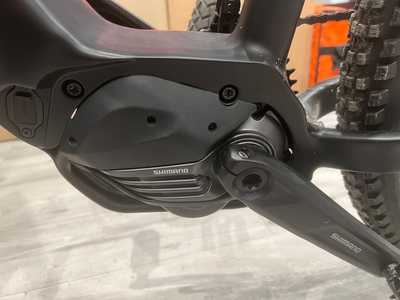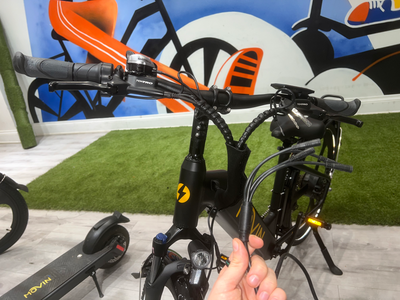Do all your electric bicycles use Shimano derailleurs
Yes we have Shimano derailleurs on all our ebikes. Shimano are considered better than many other brands due to their reliability, precision, and smooth shifting performance. Shimano has a reputation for producing high-quality components with advanced engineering, offering consistent and accurate gear changes. They are also known for being durable and able to withstand tough riding conditions. Additionally, Shimano derailleurs often feature wide compatibility, making them easy to integrate with a variety of bikes and gear systems. Their vast range of models caters to both entry-level riders and professionals, ensuring there's a Shimano derailleur suitable for nearly any cycling need.
What is a rear derailleur
A rear derailleur is a key component of a bicycle’s drivetrain that shifts the chain between the gears on the rear cassette, allowing the rider to change gears smoothly. It works by moving the chain sideways across the sprockets of the cassette, adjusting the bike's resistance and enabling the rider to adapt to different terrains or speeds. The rear derailleur is typically controlled by a gear shifter on the handlebars and includes a tension spring to keep the chain tight while riding. It plays a crucial role in maintaining efficient pedaling and gear transitions.
Basic components of a Shimano rear derailleur
Cage:
- This is the long arm that holds the jockey wheels (guide pulley and tension pulley). It moves the chain between gears and keeps the chain tensioned.
Jockey Wheels (Guide Pulley and Tension Pulley):
- These two small wheels guide the chain and maintain proper tension. The guide pulley directs the chain onto the cassette, while the tension pulley keeps the chain taut.
Limit Screws:
- These are adjustment screws (high limit and low limit) that set the maximum and minimum positions of the derailleur, preventing the chain from overshifting off the cassette.
B-Screw:
- This screw adjusts the distance between the top jockey wheel and the cassette to ensure smooth shifting across all gears.
Parallelogram Mechanism:
- This structure allows the derailleur to move laterally and shift the chain across the cassette sprockets.
Pivots:
- The points where the derailleur’s body moves, allowing it to shift the chain and maintain tension.
Hanger:
- This is the part that attaches the derailleur to the bike frame, typically near the rear axle.
Cable Anchor Bolt:
- This is where the shift cable is secured to the derailleur. It controls the movement of the derailleur in response to gear shifts.
How does a rear derailleur work on an e-bike
-
Gear Shifting: The rider uses a gear shifter (usually located on the handlebars) to select a gear. When the gear is shifted, the tension on the derailleur cable changes, causing the rear derailleur to move sideways along the cassette.
-
Chain Movement: The rear derailleur moves the chain from one sprocket to another on the cassette, adjusting the gear ratio. Lower gears (larger sprockets) are used for climbing or when more torque is needed, while higher gears (smaller sprockets) are for speed on flat terrain.
-
Parallelogram Motion: The derailleur’s parallelogram mechanism allows the cage to move laterally, guiding the chain across the sprockets smoothly.
-
Tension Maintenance: The derailleur’s tension spring and jockey wheels (pulleys) keep the chain tight, ensuring it stays aligned with the selected gear.
-
Motor Assistance: While the derailleur changes gears, the e-bike’s motor assists the pedaling effort. In lower gears, the motor may provide extra torque for uphill climbs, and in higher gears, it can assist with maintaining speed.
-
Smooth Integration: On many e-bikes, the motor controller and derailleur work together to ensure smooth shifting. The motor might momentarily reduce power during a shift to prevent excessive strain on the drivetrain.
Common problems with a Shimano rear derailleur
-
Misaligned Derailleur Hanger: If the hanger (which connects the derailleur to the bike frame) is bent or misaligned, it can cause poor shifting or prevent the derailleur from reaching certain gears.
-
Poor Cable Tension: Improper cable tension can cause slow, inaccurate, or failed shifts. If the tension is too loose, the derailleur won’t move far enough, and if too tight, it may overshoot the gears.
-
Dirty or Worn-Out Cables: Dirt, grime, or wear in the derailleur cables or housing can cause friction, resulting in sluggish shifting or imprecise movement.
-
Worn or Dirty Jockey Wheels: The guide and tension pulleys (jockey wheels) may wear out over time or become clogged with dirt, affecting smooth chain movement and derailleur efficiency.
-
Limit Screw Misadjustment: The high and low limit screws control the range of the derailleur. If improperly adjusted, the derailleur may overshift or undershift, leading to chain drops or inability to reach certain gears.
-
B-Screw Misadjustment: The B-screw controls the distance between the top pulley and the cassette. If it's not properly adjusted, shifting can be slow or noisy, especially in the larger gears.
-
Chain Wear: A stretched or worn chain can cause the derailleur to struggle with shifting accurately, leading to skipped gears or chain slippage.
-
Derailleur Cage Damage: If the derailleur cage is bent, it can affect the tension on the chain and lead to poor gear transitions or even chain drops.
-
Clutch Malfunction (in some models): Some Shimano derailleurs have a clutch mechanism to reduce chain slap. If the clutch becomes stiff or fails, it can affect chain tension and cause noisy or rough riding.
What causes a derailleur to go out of alignment
Accidental Impact or Crash:
- If the bike falls over, crashes, or the derailleur gets hit (e.g., in a bike rack or by debris), the derailleur hanger can easily bend, knocking the derailleur out of alignment.
Bent Derailleur Hanger:
- The hanger, which connects the derailleur to the bike frame, is often made of soft metal to absorb impacts. A bent hanger is one of the most common causes of derailleur misalignment.
Chain Overstretching:
- If the chain gets jammed or overstretched, it can pull on the derailleur, causing it to misalign or bend. This is more likely to happen if the chain skips off the cassette.
Poor Installation or Adjustment:
- If the derailleur or hanger wasn't installed correctly or adjusted properly, it may not be aligned with the cassette from the start, causing poor shifting and further misalignment over time.
Regular Wear and Tear:
- Over time, regular use can lead to gradual misalignment, especially if the bike is subjected to rough terrain or conditions that cause constant stress on the derailleur and hanger.
Cable Tension Issues:
- Improper cable tension can strain the derailleur, especially when shifting, leading to gradual misalignment. Frayed or worn cables can exacerbate the problem.
Off-road or Rough Terrain:
- Riding on uneven or rough surfaces can jostle the derailleur and may eventually knock it out of alignment, especially on mountain or gravel bikes.
Improper Cable Tension:
- If the derailleur cable is too tight or too loose, it can cause sluggish or inaccurate shifting. Adjust the barrel adjuster to fine-tune the cable tension for smoother shifts.
Worn or Dirty Cables:
- Dirt, grime, or worn-out cables can cause friction, leading to slow or imprecise shifting. Regular cleaning and replacing old cables can help restore proper shifting.
Misaligned Derailleur Hanger:
- A bent or misaligned derailleur hanger can prevent the derailleur from moving correctly across the cassette, causing poor shifting. You may need to straighten or replace the hanger.
Limit Screws Out of Adjustment:
- The high and low limit screws control how far the derailleur can move across the cassette. If these screws are not properly set, the derailleur may overshift or fail to reach certain gears.
Dirty or Worn Chain/Cassette:
- A dirty or worn chain or cassette can interfere with smooth shifting. Regular cleaning and replacing worn drivetrain components can resolve this.
B-Screw Misadjustment:
- The B-screw controls the distance between the top pulley and the cassette. If it’s too close or too far, shifting may become difficult, particularly in the larger gears.
Derailleur Cage Issues:
- If the derailleur cage is bent or damaged, it can affect the chain tension and derailleur alignment, leading to poor shifts.
Clutch Issues (on certain Shimano models):
- If your derailleur has a clutch, it could be stiff or malfunctioning, which can affect chain tension and cause shifting problems.
Incorrect Chain Length:
- If your chain is too long or too short, it can cause shifting issues and affect derailleur performance. Make sure your chain is the correct length for your bike's drivetrain setup.
What tools do I need to adjust a rear derailleur
Bike Multi-tool or Hex Wrenches (typically 4mm or 5mm):
- For adjusting the derailleur's mounting bolt and making tension adjustments on the derailleur or cable.
Phillips or Flathead Screwdriver:
- To adjust the limit screws (high and low) on the derailleur.
Barrel Adjuster (built-in):
- Located on the derailleur or shifter, this allows you to fine-tune cable tension without needing additional tools.
Chain Checker Tool (optional):
- To check if the chain is worn and potentially causing shifting issues.
Needle-nose Pliers (optional):
- For pulling the derailleur cable tight when adjusting cable tension or replacing the cable.
Bike Stand (optional):
- To hold the bike upright and make derailleur adjustments easier and more precise.
How often should I adjust my e-bike’s derailleur
After Initial Break-In Period:
- After the first few weeks of riding a new e-bike, cables and components may settle, so a derailleur adjustment is often required to maintain smooth shifting.
Every 2-3 Months (or after approximately 500-1000 km):
- Regular adjustments are recommended every few months to ensure the derailleur stays aligned and the cable tension is correct, especially if you're a frequent rider.
After a Crash or Impact:
- If your bike falls or experiences an impact, the derailleur may get knocked out of alignment, requiring immediate adjustment.
When Shifting Becomes Sluggish:
- If you notice slower or inaccurate shifting, skipping gears, or chain noise, it’s time to check and adjust the derailleur.
Following Routine Maintenance:
- Whenever you clean or replace parts like the chain, cassette, or cables, it's a good idea to check the derailleur alignment and make necessary adjustments.
Can I adjust my Shimano derailleur myself
Yes, you can. We have instruction how to do it:
Check the derailleur hanger:
- Ensure the derailleur hanger is straight. A bent hanger can cause poor shifting and needs to be fixed or replaced before adjustments.
Adjust the limit screws:
- Use a Phillips screwdriver to adjust the high and low limit screws. These screws prevent the chain from shifting off the cassette.
- The high limit screw (marked "H") controls the derailleur’s movement toward the smaller cog.
- The low limit screw (marked "L") controls the movement toward the larger cog.
Set the cable tension:
- Shift to the smallest cog (hardest gear), then use the barrel adjuster to fine-tune the cable tension.
- If shifting is slow to the next gear, turn the barrel adjuster counterclockwise to increase tension.
Adjust the B-screw:
- The B-screw adjusts the gap between the top pulley and the cassette. Ensure the derailleur’s upper pulley is close to but not touching the cassette when in the largest cog.
- Turn the B-screw clockwise to increase the gap or counterclockwise to reduce it.
Test shifting:
- Shift through all the gears while turning the pedals. Fine-tune the cable tension using the barrel adjuster until shifts are smooth and precise.
Tools Needed:
- 4mm or 5mm hex wrench (for derailleur mounting bolts).
- Phillips screwdriver (for limit screws).
- Barrel adjuster (built-in on derailleur or shifter).
- Optional: Bike stand for ease of adjustment.
Or you can order professional service where we can adjust it in 10 minutes.
How does a Shimano derailleur affect electric bike performance
Efficient Power Transfer:
- A well-adjusted Shimano derailleur allows the rider to shift gears seamlessly, ensuring that the bike operates efficiently at different speeds and inclines. This helps the rider use the motor and pedaling effort more effectively, especially when transitioning between uphill and flat terrain.
Improved Range:
- By enabling smooth gear transitions, the derailleur helps optimize the use of the e-bike's motor and battery. Proper gear selection can reduce strain on the motor, improving energy efficiency and extending the bike’s range on a single charge.
Enhanced Riding Comfort:
- Shimano derailleurs are known for their precise and reliable shifting. This ensures that riders experience less chain slippage, skipped gears, or rough transitions, providing a smoother and more comfortable ride.
Motor and Drivetrain Longevity:
- Smooth shifting reduces unnecessary strain on the motor, chain, and cassette. This prolongs the lifespan of the drivetrain components and reduces the risk of damage or wear caused by inefficient gear changes.
Adaptability to Terrain:
- Electric bikes equipped with Shimano derailleurs allow riders to quickly adjust to varying terrains by shifting to the appropriate gear, helping the motor perform optimally, whether climbing hills or riding on flat surfaces.





